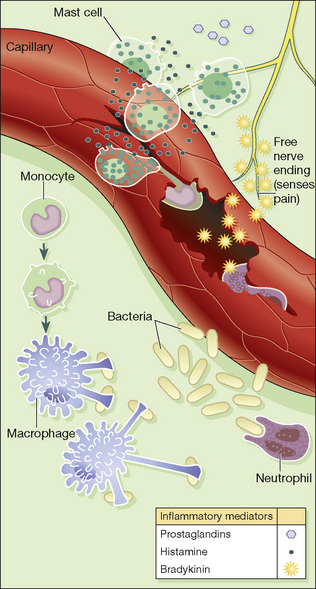2.2 Processes of disease
Chapter 2.2a Processes of disease
Aetiology of disease
• congenital defects (acquired between the time of conception and birth)
• physical trauma (including extremes of temperature and radiation)
• effects of drugs, chemicals and toxins
• degeneration (resulting from overuse and ageing)
• unknown cause (idiopathic or essential)
• iatrogenic (caused by medical treatment) – this category will of course overlap with any one of the others.
The terms ‘idiopathic’ and ‘essential’ may be ascribed to diseases of unknown cause (e.g. idiopathic thrombocytopenic purpura and essential thrombocythaemia) (see Q 2.2a-1) .
.
Processes of disease
• inflammation (redness, swelling, heat, pain and loss of function of tissues)
• tumours (excessive and inappropriate growth of cells)
• abnormal immune mechanisms (either under- or overactive immune responses)
• thrombosis, embolism and infarction (excessive and inappropriate clotting)
• degeneration (wearing out of tissues through ageing or trauma)
• metabolic abnormalities (homeostatic biochemical functions of the cells become imbalanced)
• genetic abnormalities (the cells carry defective genetic material that means they function in a less than healthy way)
The principles of genetic (congenital) abnormalities are presented in Chapter 1.1b, under the heading ‘Mutation’.
 Information Box 2.2a-I Processes of disease: comments from a Chinese medicine perspective
Information Box 2.2a-I Processes of disease: comments from a Chinese medicine perspective
 Self-test 2.2a Processes of disease
Self-test 2.2a Processes of disease
1. In your own words, describe each of the seven processes of disease.
2. Give one example of a disease with pathology resulting from each of the seven processes of disease.
3. Name one Chinese medicine diagnosis that might be associated with each disease process.
Answers
1. Inflammation: a response of tissues to damage.
Tumours: excessive cell production leading to the development of a mass.
Degeneration: due to deterioration of the body structures.
Metabolic abnormalities: a loss of balance of the usual chemical processes that comprise metabolism.
2. Examples of diseases are too various to list. Refer to the table in the answer to the last question to check your answers.
3. Simple energetic interpretations of the seven process of disease are:
Chapter 2.2b Inflammation
Physiology of acute inflammation
The five characteristics of inflammation are listed in the Table 2.2b-I.
Table 2.2b-I The characteristics of inflammation
Some of the changes that occur in inflammation are summarised in Figure 2.2b-I.
Chronic Inflammation
The resolution of inflammation may be hindered by a poor blood supply, the presence of a foreign body or as a response to certain organisms. In the case of chronic inflammation, after a time increasing numbers of lymphocytes get attracted to the area and the scar-tissue forming cells, the fibroblasts, are continually activated meaning excess scar tissue may be formed. The chronic skin ulcer described in Chapter 2.1b is an example of chronic inflammation. Tuberculosis (TB) is an example of an infection in which the slow-growing infectious organism Mycobacterium tuberculosis encourages a chronic inflammatory response and the formation of clusters of immune cells around foci of infection known as granulomas (see Q2.2b-4) . These tiny clusters of immune cells are characteristic of this disease and are evidence to the pathologist of its ability to induce damaging chronic inflammation.
. These tiny clusters of immune cells are characteristic of this disease and are evidence to the pathologist of its ability to induce damaging chronic inflammation.
 .
. .
.
 .
. Information Box 2.2b-I
Information Box 2.2b-I .
. Information Box 2.2b-II
Information Box 2.2b-II



